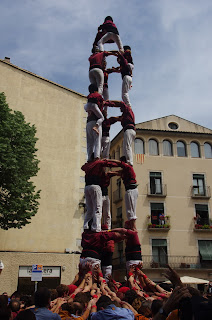 |
| Unusual rock formations at the top of the mountain |
 |
| Santa Maria de Montserrat |
The weathering of the mountain has given the stones their peculiar aspect with a multitude of rock formations which are visible and easily recognisable from a great distance. Not surprising then that it has been a place of worship for centuries and a Monastery was first built here in the 9th Century to house an idol of the Virgin Mary (the black virgin). The little monastery soon began to receive pilgrims and very quickly the word spread of the miracles and wonders that were said to be performed by the Virgin. The Monastery and its power and influence began to grow until in 1409 it became an independent abbey. From 1493 to 1835, the monastery grew increasingly in wealth and splendour to become what it is today.

During the rule of Francisco Franco, Santa María de Montserrat was seen as a sanctuary for scholars, artists, politicians and students. Quite possibly due to it's resistance to the Franco regime, it has become a symbol of Catalan Nationalism. On 27 April 1947, a Mass was held to celebrate the Enthronement of the Virgin of Montserrat which was attended by over 100,000 people. At the Mass, prayers were publicly said in the Catalan language, defying the government's language policies.
This mountain was also the inspiration for the name of the Island of Montserrat, named by Christopher Columbus in 1493 and its location is also rumoured to be one of the resting places of the Holy Grail of Arthurian legend.Apart from the religious connotations, the mountain is also a great destination for a fantastic day out hiking ! The main peaks are Sant Jeroni (1,236 m), Montgrós (1,120 m) and Miranda de les Agulles (903 m) and they can be reached by the "path of 5000 steps" from the Monastery. There is no water on the mountain and it gets very hot in the high summer. We recommend hiking the trails in the Spring and Autumn and bring plenty of suncream, water and a picnic. The full route up to the top, around the peaks and back to the car park at the abbey will take you about 8 hours. For those that are not so energetic, there are funicular railways and cable cars that link some of the more popular viewpoints. There is a restaurant at the abbey, but it is very touristy, expensive and along the lines of a cafeteria rather that a calm, quiet, relaxing place to eat.

If you choose to bring your dog, be aware that animals are not allowed on any of the public transport or in any of the public buildings. A visit to the mountain of Montserrat is the perfect day out for some fresh air and a little exercise. Avoid the weekends as it is a very popular destination for people escaping the heat of the city in Barcelona. It takes about 90 minutes to get there from the Villa and there is substantial parking for a small fee at the abbey. Aim to get there early though as the parking is not unlimited.
#caldomino #catalunya #costabrava #montserrat #hiking
About me… I have lived in Calonge (province of Girona) on the Costa Brava since 2003 after retiring as a pilot from the british Royal Air Force. My passions are hiking, biking, skiing, photography and discovering and sharing the hidden cultural treasures of this beautiful country. My day job entails managing a luxury self-catering rental Villa, Casa Cal Domino, and in my search for new and interesting things to do for my clients whilst they are here on holiday, I have been genuinely overawed by the beauty and diversity of this land. I’m not leaving any time soon. I love it here and I hope to inspire you to come and discover this wonderful country for yourself.













.png)















